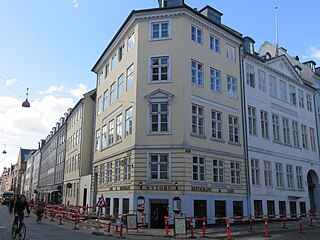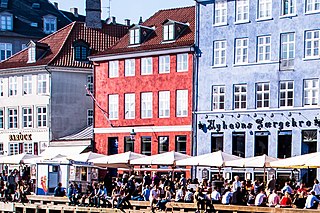
The Assessor Bachmann House is a historic property located at Gammeltorv 18 in the Old Town of Copenhagen, Denmark. It houses the private equity fund Maj Invest.

The Brigadér Halling House is a listed property at Lille Strandstræde 14 in central Copenhagen, Denmark. It takes its name from William Halling, a Dane who acquired the building shortly after returning to Denmark from India where he had served in the British army. He was known as Brigadér Halling after he acquired the title Brigadér in 1872. The building now houses the Maltese embassy.

Nyhavn 51 is an 18th-century canal house overlooking the Nyhavn canal in central Copenhagen, Denmark.Above the door is a painted stone relief depicting a lamb. The property was formerly known as Lammet and the sign was used for identification in a time when house numbers had still not been introduced. The letters are the initials of the builder Henrich Lambertsen Engel and his wife Karen Nielsdatter Holm. The building was listed in the Danish registry of protected buildings and places in 1918. It was subject to Schalburgtage during World War II but restored. Notable former residents include the portrait painter Hans Jørgen Hammer, the marine artist Carl Frederik Sørensen and Swedish actress Eva Eklund.

The Verrayon House is a Rococo, bourgeoisie townhouse located at Lille Strandstræde 6 in central Copenhagen, Denmark. It was listed by the Danish Heritage Agency in the Danish national registry of protected buildings in 1943.

Nyhavn 67 is a listed property overlooking the Nyhavn Canal in central Copenhagen, Denmark. The writer Hans Christian Andersen lived in the building as a lodger with only short interruptions from 1848 to 1865.

Nyhavn 13 is a historic townhouse overlooking the Nyhavn Canal in central Copenhagen, Denmark. With roots dating back to the late 17th century, it owes its current appearance to a heightening of the building with two floors in 1842. Notable former residents include the businessman Abraham Marcus Hirschsprung and the painter and educator Wilhelm Kyhn. The building was listed in the Danish registry of protected buildings and places in 1945.

Nyhavn 19 is a property located at the corner of Nyhavn and Lille Strandstræde in central Copenhagen, Denmark. The building was listed on the Danish registry of protected buildings and places.

Lille Strandstræde 10 is an 18th-century property situated in the Nyhavn Quarter of central Copenhagen, Denmark. It was listed in the Danish registry of protected buildings and places in 1988.

Lille Strandstræde 18 is a Neoclassical property situated off Sankt Annæ Plads in central Copenhagen, Denmark. It was listed in the Danish registry of protected buildingsand places om 1950-

Lille Strandstræde 12 is an 18th-century property situated in the Nyhavn Quarter of central Copenhagen, Denmark. The building owes its current appearance to an adaptation in 1858. It was listed in the Danish registry of protected buildings and places in 1950. Botable former residents include the politician Peter Sabroe-

Vingårdstrøde 19 is a Neoclassical property situated on Vingårdstræde, between Kongens Nytorv and Nikolaj Plads, in central Copenhagen, Denmark. Like most of the other buildings in the area, the building was constructed as part of the rebuilding of the city following the Copenhagen Fire of 1795. It was listed in the Danish registry of protected buildings and places in 1959. A number of people associated with the Royal Danish Theatre have resided in the building, including ballet dancers and choreographers Antoine Bournonville, August Bournonville and Carl Dahlén, as well as a number of members of the Royal Danish Orchestra. Other notable former residents include future cookbook writer Anne Marie Mangor, portrait painter Johan Frederik Møller and sculptor Daniel Peter Støhrmann.

Nytorv 15/Rådhusstræde 2 is a Neoclassical property situated at the corner of Nytorv and Rådhusstræde in the Old Town of Copenhagen, Denmark. It consists of two separate buildings, the corner building from 1797 and an eight-bay building from 1798, now connected by a narrow modern infill. The building was listed in the Danish registry of protected buildings and places in 1945. Notable former residents include jurist, writer and publisher Jacob Just Gudenrath (1657–1825), actors Stephan and Eline Heger, theatrical painter Edvard Lehmann and portrait painter hristian Frederik Christensen (1805-1883).

Nyhavn 45 is an 18th-century property overlooking the Nyhavn Canal in central Copenhagen, Denmark. It was listed in the Danish registry of protected buildings and places in 1945.

Nyhavn 3 is an 18th-century property overlooking the Nyhavn Canal in central Copenhagen, Denmark. It was listed in the Danish registry of protected buildings and places in 1945.

Nyhavn 37 is an 18th-century property overlooking the Nyhavn Canal in central Copenhagen, Denmark. A distillery was based in a rear wing from a least 1731 until at least the 1860s. The building was heightened with one storey in 1791. The building was listed in the Danish registry of protected buildings and places in 1923.

Lille Strandstræde 8 is an 18th-century property situated around the corner from Nyhavn in central Copenhagen, Denmark. Constructed as a two-storey, half-timbered building for Andreas Bodenhoff in the middle of the century, it was later first reconstructed in brick and heightened with two storeys in 1783 and then, in 1932, expanded with a seven-bays-long side wing on the rear. The building was listed in the Danish registry of protected buildings and places in 1959. Notable former residents include the German painter Bernhard Mohrhagen and the veterinarian Viggo Stockfleth.

Nyhavn 20 is a 17th-century building overlooking the Nyhavn canal in central Copenhagen, Denmark. It was listed in the Danish registry of protected buildings and places in 1945. The building houses a bar in the basement and a residential apartment on the upper floors. The facade features a relief of a fish above the main entrance, flanked by two reliefs of sailing ships.

Nyhavn 21/Lille Strandstræde 4, formerly known as Hotel L'ven, Hotel Kronprinsen and Fredsfondens Hus, is a complex of historic buildings overlooking the Nyhavn canal in central Copenhagen, Denmark. It consists of a late 17th-century building in Nyhavn and a just two bays wide building in Lille Strandstræde as well as a two-storey rear wing from 1748. It was listed in the Danish registry of protected buildings and places in 1945. The restaurant Cap Horn was a popular jazz venue in the 1950s. It is now part of the Tholstrup restaurant group. Notable former residents include the politician Jens Christian Christensen and painters Anna and Michael Ancher.

Kvæsthusgade 1/Nyhavn 69 is a three-storey building situated at the corner of Nyhavn and Kvæsthusgade. A memorial featuring a bust of a diver wearing a diving helmet commemorates that Em. Z. Svitzer's Bjernings-Enterprise, a salvage company founded by Emil Zeuthen Svitzer back in 1833, was once headquartered in the building. Notable former residents include the actress Magda von Dolcke.

Købmagerhus is a commercial building situated at the corner of the shopping street Købmagergade and Silkegade in central Copenhagen, Denmark, built in 1898 to a Jugend style design by Chr. Hansen. A plaque on the facade commemorates that Niels Steensen was born on the site. Café de Grandeville, a café with live music, was originally located on the ground floor of the building. Its former premises were later converted into a cinema, Højbro Teatret, with just 251 seats, An earlier building on the site was built in 1731 for court jeweller Frederich Fabricius. It was later passed to his son and grandson, Christopher and Frederik Fabricius, both of whom also served as court jewellers. Copenhagen's first gentlemen's club, referred to variously as Fabricius' Club and "the club on Købmagergade", was based in the building.


























